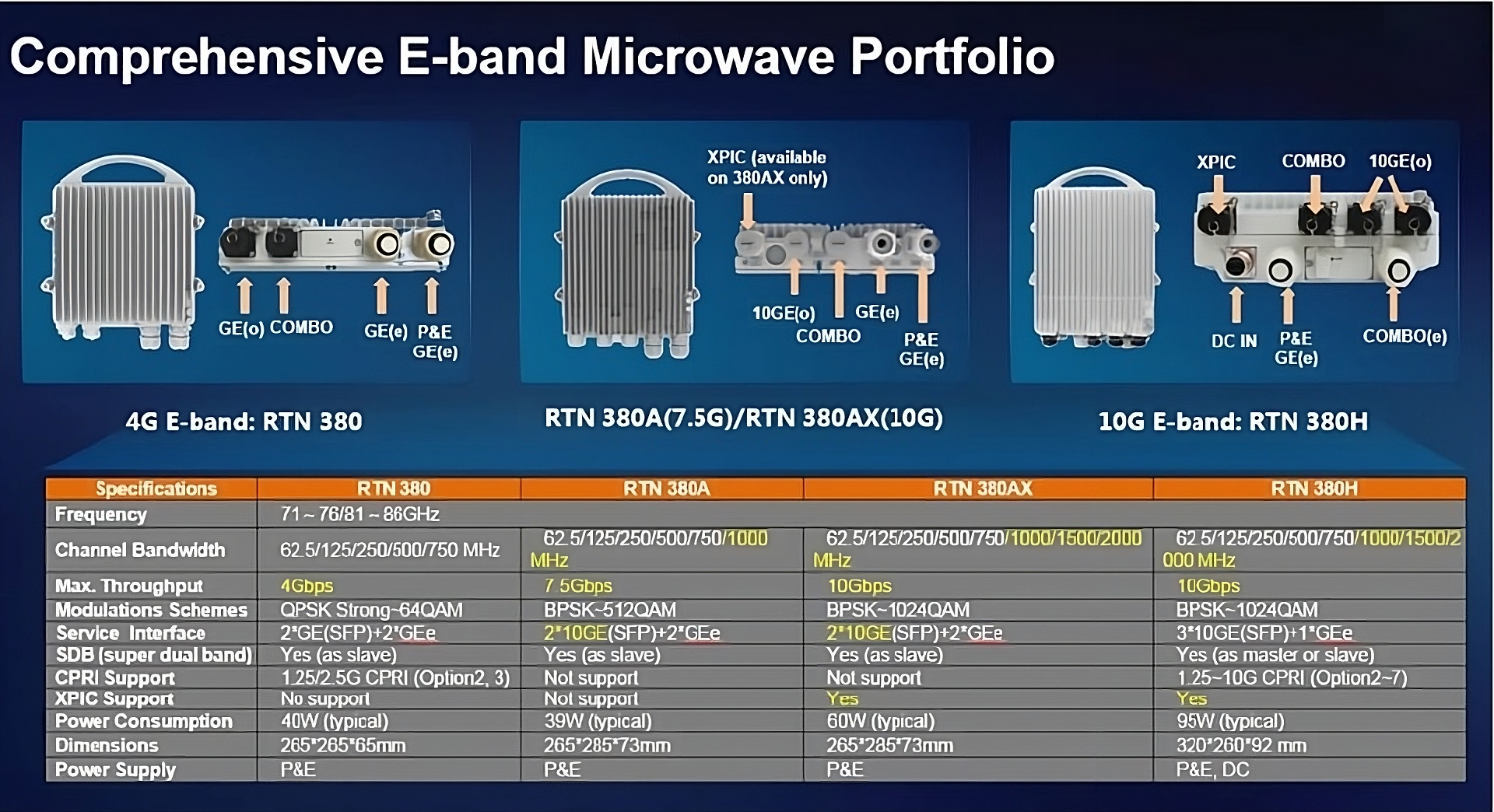Huawei E-band Microwave Portfolio: A Comprehensive Product Explanation
Keywords :RTN 380, RTN 380A, RTN 380AX, and RTN 380H
As the development of 5G communication networks accelerates, mobile operators are increasingly facing the need for higher transmission capacity and broader bandwidth to support massive data transfers and ultra-fast connectivity. Huawei’s E-band microwave transmission solutions, particularly its comprehensive product lineup, including RTN 380, RTN 380A, RTN 380AX, and RTN 380H, address these evolving demands. These products support 4G and 10G requirements, making them indispensable in mobile backhaul networks.
Huawei’s E-band microwave transmission devices operate in the frequency range of 71 GHz to 86 GHz, leveraging high-bandwidth microwave technology to enable low-latency, high-throughput, and high-speed data transmission. This article will provide an in-depth look into Huawei’s E-band microwave portfolio, examining its technical specifications, use cases, and competitive advantages.

1. Frequency and Bandwidth
Huawei’s E-band microwave transmission solutions operate within the 71 GHz to 86 GHz frequency band, providing expansive spectrum resources for high-speed data transmission. E-band frequency offers considerable advantages due to its abundant and relatively interference-free spectrum, making it ideal for wireless transmission in dense urban areas and rural regions alike.
For instance, the RTN 380 series supports frequencies in the 71-76 GHz and 81-86 GHz ranges, with channel bandwidths varying from 62.5 MHz to 2000 MHz. Different models in this series are designed to accommodate diverse bandwidth requirements:
• RTN 380 supports bandwidths up to 750 MHz,
• RTN 380A extends to 1000 MHz,
• RTN 380H reaches an impressive 2000 MHz.
This flexibility in bandwidth support makes Huawei’s E-band solutions highly adaptable to different network environments and operator needs. In particular, the RTN 380H model’s large bandwidth (up to 2000 MHz) allows for enhanced data transmission capacity, making it suitable for high-traffic backhaul applications.
2. Data Transmission Capacity and Speed
Huawei’s E-band microwave solutions are designed to deliver ultra-high data transmission rates, essential for the demands of 5G networks. E-band’s high-frequency spectrum, combined with large channel bandwidth, allows Huawei’s devices to achieve incredible throughput. For example:
• The RTN 380 supports a maximum data transmission rate of 4 Gbps,
• The RTN 380AX and RTN 380H models support up to 10 Gbps.
These high transmission rates make E-band microwave devices particularly suitable for carrying 5G backhaul traffic, which requires massive capacity to handle increased data loads from 5G base stations.
Furthermore, Huawei provides scalable transmission options across its product portfolio, allowing operators to choose devices that meet their current needs while offering room for future growth as network demands increase.
3. Advanced Modulation Technologies
One of the key technological strengths of Huawei’s E-band portfolio is its use of advanced modulation schemes. The RTN 380 series employs high-efficiency modulation technologies, including:
• QPSK and 64QAM for RTN 380,
• 512QAM and 1024QAM for RTN 380A and RTN 380AX.
These advanced modulation techniques significantly increase spectral efficiency, enabling higher data transmission rates within the same bandwidth. By supporting higher-order modulation schemes, Huawei’s E-band devices optimize performance, ensuring that operators can achieve maximum data throughput, even in spectrum-constrained environments.
Moreover, RTN 380H supports XPIC (Cross Polarization Interference Cancelling) technology, which allows for further spectral efficiency gains by enabling dual-polarization transmission. This is particularly beneficial in densely deployed urban networks, where spectrum availability is a critical constraint.
4. Service Interface and Flexibility
Huawei’s E-band microwave portfolio also offers versatile service interfaces, catering to the needs of various network configurations. For example:
• RTN 380 provides 2xGE (SFP) + 2xGE (electrical) interfaces,
• RTN 380AX upgrades this to 2x10GE (SFP) + 2xGE, allowing for higher data throughput,
• RTN 380H supports 3x10GE (SFP) + 1xGE, ensuring that the system can handle high-capacity backhaul links efficiently.
This flexibility in interface options enables network operators to select the most suitable solution for their network architecture, whether they are supporting a smaller-scale regional network or a large-scale metropolitan network. In addition, the ability to mix and match different interfaces simplifies network deployment and ensures seamless integration into existing network infrastructures.
5. CPRI Support for Mobile Backhaul
Another crucial feature of Huawei’s E-band microwave solutions is their support for Common Public Radio Interface (CPRI), a key requirement for mobile backhaul in 5G networks. CPRI enables direct interconnection between base stations and remote radio units, allowing for low-latency, high-capacity communication.
Huawei’s RTN 380A, RTN 380AX, and RTN 380H models all support CPRI, ranging from 1.25 Gbps to 10 Gbps. This support extends to CPRI Option 7, ensuring that operators can meet the stringent latency and capacity requirements of modern 5G backhaul systems. This CPRI support, combined with high throughput and low latency, makes Huawei’s E-band solutions particularly well-suited for front-haul and backhaul applications in 5G networks.
6. Energy Efficiency and Power Consumption
Energy efficiency is another critical factor in microwave transmission technology, especially as operators look to reduce operational expenditures (OPEX) while expanding their networks. Huawei’s E-band microwave products are designed to minimize power consumption without sacrificing performance.
• The RTN 380 consumes 40W (typical),
• The RTN 380AX consumes 60W,
• The RTN 380H has a slightly higher power consumption of 95W, due to its higher performance capabilities.
Despite these figures, Huawei has optimized the power efficiency of its devices to ensure that operators can deploy them in a wide range of environments, from densely populated urban centers to remote rural areas, without excessive power consumption.
7. Compact Design and Easy Deployment
Huawei’s E-band microwave devices are designed with compact form factors, facilitating easy installation and deployment in diverse environments. The dimensions of these products vary slightly by model, but all are optimized for minimal footprint and ease of integration:
• RTN 380: 265 mm x 265 mm x 65 mm,
• RTN 380A and RTN 380AX: 265 mm x 285 mm x 73 mm,
• RTN 380H: 320 mm x 260 mm x 92 mm.




